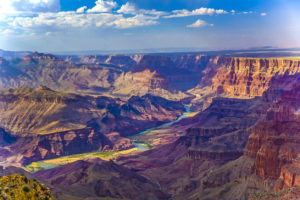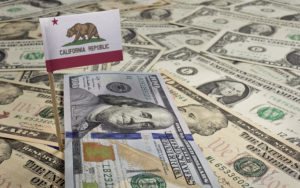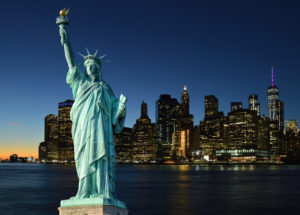FOCUS ON ARIZONA

This southwestern state is best known for the Grand Canyon,
the mile-deep chasm carved by the Colorado River. Flagstaff, a ponderosa
pine-covered mountain town, is a major gateway to the Grand Canyon. Other
natural sites include Saguaro National Park, which protects the cactus-filled
Sonoran Desert Landscape. Tucson is home to the University of Arizona and to
the Arizona-Sonora Desert Museum.
Southern Arizona is known for its desert climate, with very
hot summers and mild winters. Northern Arizona features forests of pine,
Douglas fir, and Spruce trees, the Colorado Plateau, some mountain ranges
(e.g., the San Francisco Mountains), as well as large deep canyons, with much
more moderate summer temperatures and significant winter snowfalls. There are
ski resorts in the areas of Flagstaff, Alpine, and Tucson. In addition to the
Grand Canyon National Park, there are several national forests, national parks,
and national monuments in the state.
Are you an Amazon FBA Seller Who Owes California Taxes? You Need to Act Right Now!

Does your company now, or has it in the past, taken advantage of Fulfillment by Amazon (“FBA”), and did you recently receive a letter stating you owe California taxes? This blog post explains why you cannot ignore this letter. Please contact us right away if you need help navigating your next steps!
Physical Presence Nexus and Fulfillment by Amazon
Back before Wayfair made headlines and the concept of economic nexus became a household term, essentially giving states the ability to pursue collection of sales tax from internet retailers, “physical presence” still established nexus within a state. A variety of factors determined physical presence nexus, such as employees located within a state, or owning or renting property within the state.
One such obvious physical presence item coming into play for a lot of companies that participate in FBA is inventory. If a company’s physical property (inventory) is held within a state (even if held in a third-party warehouse, like Amazon’s), it creates nexus, or taxable presence, for the company. That means that the company is then responsible for collecting and remitting the state’s sales/use tax and also filing income tax returns in the state.
New York Finally Boards the Wayfair Train

In the United States, the sales tax landscape has changed dramatically due to the recent U.S. Supreme Court Case of South Dakota v. Wayfair (June 2018). Following this landmark decision which made it easier for companies to create nexus in states, many states have enacted legislation which create guidelines/thresholds for economic nexus. In a previous blog, we talked about this epic decision. Through December, over 30 states had enacted economic nexus legislation. But we had not heard from New York.
Online Sales Tax & SaaS Companies: What You Need to Know in 2019

Although the Wayfair online sales tax ruling doesn’t relate specifically to SaaS, states are enacting laws that make it easier to create nexus, which means all companies - including SaaS - need to be more diligent in determining whether they’re subject to taxes in various states.
What exactly do SaaS companies need to know about Wayfair, the online sales tax debate, and how it may affect them?
How Online Sales Tax Legislation Affects SaaS Companies
Law360 does a good job of explaining why SaaS companies especially need to pay attention to the new online sales tax legislation states are enacting.
First, due to their solutions’ accessibility via the cloud, SaaS companies often have a wider array of sales by state; thus, an elevated risk of expansive nexus. Second, the SaaS pricing model generally breaks out the contract into monthly transactions. Consequently, the common 200 plus transaction portion of states’ economic nexus laws are far more attainable under the SaaS pricing model. Rather than needing to have 200 customers in a state, SaaS companies may trigger nexus in a state with only 17 customers and perhaps fewer in the event of other separately invoiced services.
Miles Consulting Welcomes Bill Loew

Miles Consulting Group is excited to announce the addition of Bill Loew to our state tax consulting team. Bill has been a friend and colleague of mine for many years. Having someone of his character and caliber join the firm at this crazy juncture in state tax consulting is a real privilege.
Bill has had a very impressive career, starting as an auditor at the California State Board of Equalization (now the CDTFA), to ultimately becoming a partner in two Big 4 public accounting firms, and most recently consulting with clients at a boutique firm. Over the years, we've worked on several client engagements together in various capacities and I'm so excited that we'll be doing that on a day-to-day basis now going forward.
FOCUS ON FLORIDA
Welcome to Florida!
Florida is the southeasternmost U.S. State, with the Atlantic Ocean on one side and the Gulf of Mexico on the other. It has hundreds of miles of beaches. The city of Miami is known for its Latin-American cultural influences and notable arts scene, as well as its nightlife, especially in upscale South Beach. Orlando is famed for its theme parks including Walt Disney World.
Florida is the flattest state in the United States. Lake Okeechobee is the largest freshwater lake in the state.
Central Florida is known as the lightning capital of the United States, as it experiences more lightning strikes than anywhere else in the country. Florida leads the United States in tornadoes per area (when including waterspouts), but they typically do not reach the intensity of those in the Midwest and Great Plains. Hail often accompanies the most severe thunderstorms. Hurricanes pose a severe threat each year during June 1 to November 30, hurricane season, particularly from August to October.
Business Climate
The state’s economy relies mainly on tourism, agriculture, and transportation, which developed in the late 19th century. Florida is also renowned for amusement parks, orange crops, winter vegetables, the Kennedy Space Center, and as a popular destination for retirees.
Tourism makes up one of the largest sectors of the state economy. Amusement parks, especially in the Greater Orlando area, make up a significant portion of tourism. The Walt Disney World Resort is the most visited vacation resort in the world. Many beach towns are popular tourist destinations, particularly during winter and spring break.
Agriculture is the second largest industry in the state. Citrus fruit, especially oranges, are a major part of the economy, and Florida produces the majority of citrus fruit grown in the United States. Other products include sugarcane, tomatoes, and celery. The state is the largest producer of sweet corn and green beans in the U.S. Florida is the largest producer of watermelons in the country. It also produces the most tomatoes, strawberries and sugar.
Phosphate mining, concentrated in the Bone Valley located in central Florida, is the state’s third-largest industry. Florida currently contains the largest known deposits of phosphates in the U.S. The state produces about 75% of the phosphate required by farmers in the U.S. and 25% of the world supply, with about 95% used for agriculture and 5% used for other products.
Tax Climate
Florida does not have an individual income tax.
The state imposes a corporate income/franchise tax on all corporations for the privelage of conducting business with the state of Florida. The top corporate income tax rate is 5.5%. In general, corporations engaged in multistate business activities are required to apportion income to Florida. The apportionment fraction is based on the total of the property factor (25%), the payroll factor (25%) and a double weighted sales factor (50%).
Florida adheres to the cost of performance sourcing rules for sales of services.
Sales Tax Structure
The state sales tax rate is 6%, and ranks 16th in the nation.
Despite recent activity in many states regarding economic nexus in light of South Dakota v. Wayfair, Florida has not enacted economic legislation as yet.
Florida is favorable to taxpayers in its approach to taxation of technology products for sales tax purposes. All digital products are exempt. Prewritten and custom computer software that is electronically downloaded is exempt. Only software sold in tangible form is taxable. Lastly, all cloud services are exempt. How products are produced, sold and delivered is critical to determining their tax status.
Last year, Florida had two sales tax holidays. Residents could buy disaster preparedness items free of sales tax in the beginning part of June. For more information on last year’s sales tax holidays, click here. Residents could also buy clothing and school supplies in early August tax free. For more information on last year’s Disaster preparedness holiday, click here. This year, legislation authorizing sales tax holidays has not yet been approved.
Random Facts
- Florida’s $1.0 trillion economy is the fourth largest in the United States. If it were a country, Florida would be the 16th largest in the world, and the 58th most populous.
- PortMiami is the world’s largest cruise ship port.
- I-10, which spans 362 miles in Florida, traverses the panhandle, connecting Pensacola, Tallahassee, Lake City, and Jacksonville, with interchanges with I-75 in Lake City and I-95 in Jacksonville. It is the southernmost interstate in the United States terminating in Santa Monica with a total length of 2,460 miles.
- Florida is home to Gatorland, the Alligator capital of the World.
- The Florida Everglades is the only place on the planet where crocodiles and alligators live together.
- The highest point in Florida is Britton Hill on the Florida Panhandle and is only 345 feet above sea level.
- Saint Augustine is the oldest European settlement in North America.
- Key Largo is known as the Dive Capital of the World.
- Fort Lauderdale is known as the Venice of America because the city has 185 miles of local waterways.
Our team at Miles Consulting Group is always available to discuss the specifics of your state tax situation, whether in Florida or other states, we can help you navigate the complex tax structures arising from your multistate operations. Call us to help you achieve the best tax efficiencies.
Online Sales Tax and SaaS: A Recap of What You Need to Know

Last year was a big one in the online sales tax debate; everything changed following the Wayfair v. South Dakota Supreme Court decision. Once the ruling was announced in June, states began creating and implementing online sales tax provisions for internet retailers selling to state residents. In addition to adding uncertainty for small business trying to sort out tax code for dozens of states across the country, the ruling complicated another already-confusing situation: the taxability of SaaS (software as a service).
Online Sales Tax & SaaS in States Across the Country
How does the taxability of SaaS tie in with the Wayfair ruling? The Wayfair ruling doesn’t relate specifically to SaaS – it’s about nexus – but because states are enacting laws which now make it easier to create nexus (for instance, the South Dakota standards that started this all – sales of over $100,000 in a year OR 200 transactions), companies now need to be more diligent in determining whether their products and services are subject to tax in various states. That’s where the analysis of the SaaS revenue stream fits in. Many of our clients that were, perhaps, based in one state and may have had physical presence nexus in one or two other states didn’t have that much to worry about. But now, we need to know where their revenue streams (SaaS and others) are taxable because they are often reaching the minimum thresholds for registration, collection and filing of sales tax.
SLEEPING GIANTS AWAKEN: CA, TX & WAYFAIR

In the United States, the sales tax landscape has changed drastically due to the recent U.S. Supreme Court Case of South Dakota v. Wayfair (June 2018). Following this landmark decision which made it easier for companies to create nexus in states, many states have enacted legislation which establishes guidelines/thresholds for economic nexus. In a previous blog, we talked about this epic decision.
What is Economic
Nexus?
In the past, companies needed to have physical presence, or “boots on the ground,” in a state in order to have nexus (or taxable presence) in a state. This meant that a company needed to have offices, inventory, employees, or contractors in a state for a certain amount of time. Companies now don’t necessarily need to have physical presence in a state for them to create nexus; they now can have nexus in a state by virtue of economic nexus. Economic nexus essentially means that companies with sales of a certain dollar amount or a certain number of transactions with a state are required to register, collect and remit sales tax. Some states require both criterion. Additionally, note that some states base their economic threshold on taxable sales, while other states mention gross sales.
3 Fascinating Examples of State Tax Law Intersecting Technology

As we welcome the New Year, I thought it would be fun to look at a few areas where state tax laws and technology are coming together. Keep reading for three different updates that share ways modern tech is affecting states’ revenue.
1. Ohio Accepts Cryptocurrency for State Tax Payments
Cryptocurrency like Bitcoin has been around for a while now, yet Ohio is setting an interesting state tax precedent by allowing businesses to pay their fees with the digital currency.
This is especially interesting as these types of currency are known for volatility. However, the state’s taken this into consideration. OhioCrypto explains:
What You Need to Know About San Francisco’s New Economic Nexus & Tax Measures

Lately we’ve been sharing a lot about new economic nexus standards and measures passed in the recent election. But states aren’t the only entities with new taxes and fees; San Francisco recently passed legislation requiring companies engaging in business in the city to pay a variety of fees and taxes. Filings are due February 28, 2019, so it’s important to understand how your company might be affected.
Initiatives passed in November’s election, including Proposition C’s homeless tax and Proposition D’s tax on the cannabis industry, implement payroll expenses, gross receipts taxes and a new economic nexus standard for entities doing business within the city. Here’s an overview of the details.




















